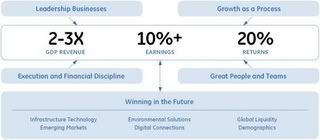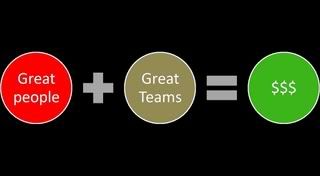Making the move from a cost center to a profit center is a daunting task that most talent management and recruiting teams don’t attempt. Yet when the economy shifts, and it will again, this might be the most important thing you can do today to ensure that your budgets don’t get cut, your staff doesn’t get slashed, and your department isn’t decimated.
The Human Capital Business Strategy
“Our people are our most important asset.”
This clich? has been used everywhere from Apple to Enron, often as lip service to employee-retention initiatives. I have yet to see a company really step up in their annual report and demonstrate that people really drive the business.
Most of them look something like GE’s annual report, which to its credit devotes a good deal of paper to human capital, but wraps it all up under this image of their business strategy:

It’s significant that “Great People and Teams” are actually on the list, as many companies can’t even say this. But notice that it’s in the lower-right quadrant of the diagram, buried behind execution and financial discipline. Personally, I think the diagram at the beginning of every annual report should look more like this:

GE makes approx. $42 billion per quarter in revenue, so obviously they’re doing something right. But what is the return on their human capital, their most important asset? They and many other companies and talent management departments are missing that consistently hiring and developing the best people drives revenue and profits for the company. This, like the return on any other asset, is quantifiable.
After all, it’s the Great People and Teams that drive all of the other elements. Who comes up with the processes that drive growth? Who identifies the businesses that are leaders rather than followers? Who’s responsible for execution and financial discipline? It’s the great people and teams, that’s who.
As such, talent management has one of the biggest potential impacts on corporate profits of any department.
Making Money with Human Capital Initiatives
Is sales really the only department that can talk like a profit center? Sales can only sell what the product teams create, and time and again it’s been shown that top sales people drive significantly more returns than their peers.
What about product development? Don’t the product teams create the product that the company sells in the first place? Without them, would profitable lines of business be possible? Of course not, but this only provides another example of how human capital drives profits, as great ideas come from great people, as I outlined in the Talent Story of the iPod.
In talent management, your impact on all of these things is usually indirect at best, which is actually pretty good when you add it all up. You don’t create the products that sell billions, you don’t actually do the selling, and you don’t set the company’s business strategy about which markets to go after. But within this framework, you can make a significant impact on top-line revenue and bottom-line profits by ensuring that the resources are in place to execute on the business strategy, identify new revenue streams, and ensure the company operates at maximum efficiency.
If the company’s goal is expansion, who you identify and hire for key sales roles can have an enormous impact on how quickly and how broadly the company and its revenues can expand. If the goal is operating efficiency, getting seasoned operations talent in place (whether internal or external candidates) can change the fortunes of your company. If the goal is innovation, talent management can have a direct impact on whether you’re positioned to hire and breed innovators. See my recent article on Idea Recruiting and Fast Company’s fascinating article on Innovation Scouts.
If You Don’t Measure it, You Won’t Improve it
Your impact on corporate performance is indeed measurable.
A statistical technique called regression analysis is one excellent way to measure your impact. The guiding principle of an effective regression analysis is to isolate certain variables (i.e., more effective talent management practices) in order to better measure their impact.
An example of this is focusing on a specific group of employees who can be tied to revenue, and implement initiatives or programs targeted toward these individuals. T-Mobile did this some time ago in their sales recruiting efforts, as have scores of other companies like Sunglass Hut. Microsoft is even beginning to experiment with this technique in its workforce-planning efforts.
These are just a few of the ways you can demonstrate your impact on revenue and profits:
- Improving the selection process for revenue-generating employees by implementing online assessments. This works particularly well for salespeople.
- Increasing the return from your employee referral program; referred employees stay longer, produce faster, and perform better.
- Ramping up proactive sourcing efforts to identify game-changing, high-impact employees who drive higher returns for the company.
- Implementing an idea or innovation recruiting initiative that yields products or services that your company sells.
- Targeting internal mobility/continuous recruiting initiatives to top performers and subsequently reducing the turnover rate of these individuals, who drive significantly more revenue and profits than their peers.
- Implementing “source optimization programs” to ensure that the top-performing sources of hire as measured in revenue generated are optimized and used more often.
You can, of course, continue to operate as a service provider that handles a largely administrative process. You can also choose to focus on reducing costs vs. generating revenue, or reducing the time it takes to hire average talent vs. taking more time to hire top performing talent.
But with outsourcing, a potential economic downturn if gas prices go any higher, and an increasingly competitive global business environment, I wouldn’t suggest it.